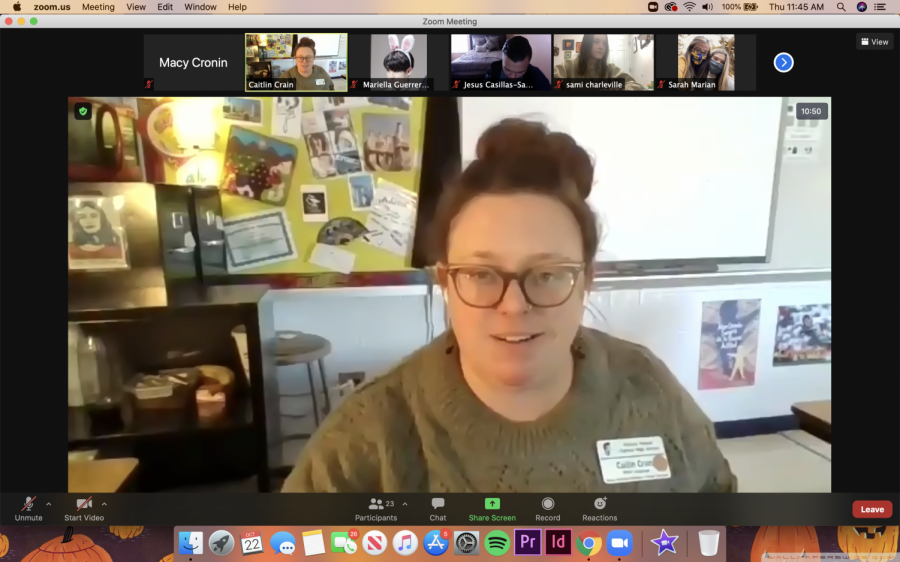Spanish Teacher Caitlyn Crain Teaches Online Classes
Credit to Macy Cronin
Published: November 4, 2020
Cashiers wear masks. Lifeguards wear masks. Students wear masks. For most of the professional world, COVID-19 has brought a change in uniform. For Spanish teacher Caitlin Crain, not only has her attire changed, but so has the way her classroom looks and operates. No longer a bustling classroom with pods and large group discussions, but instead rigid rows of desks in her room and an array of vacant screens on Zoom. With change has come a challenge that Crain has faced with perseverance and optimism.
Crain, a Francis Howell Central teacher of nine years, applied to be an online teacher in order to protect her health. In August she found out she had received the position and would teach online four hours a day and in-person two, but she had little time to prepare before classes began.
“I honestly would have beefed up my knowledge on Canvas,” Crain said. “It was kind of hard to know what to prepare for. I didn’t even know if I was going to get the virtual position. I had what, like, two weeks before teachers had to report back, so obviously it would have been nice to focus on lesson planning, but I was playing the waiting game.”
Crain spends a lot of her time planning fun activities to connect the class with each other and try and keep everything as interactive as it would be in class. Doing digital activities can sometimes bring challenges for participants. Patience Beesly, a virtual spanish four student, experiences some of those difficulties each day.
“In person I would understand at least 85% of what [Crain] was saying usually, and now it’s like it glitches and stuff like that and I also have internet issues,” Beesly said. “It’s just a lot more difficult to comprehend our work, and stuff like that.”
While her students struggle to connect digitally to Zoom calls and assignments, Crain struggles to watch as the strong relationships she fosters in-person don’t develop as rapidly online.
“I’m really struggling with not being able to see your faces,” Crain said. “I feel like you guys don’t know each other in class. It’s hard to not see people’s faces but then also not have you guys work together and be able to interact with you guys.”
Even with all the change, Crain intends to treat her virtual students as she would any other class. Coming into the year with few expectations, she strives for a class where her students can have fun and learn Spanish.
“I’m implementing the idea of grace for me and my students,” Crain said. “Sometimes I’m like, you know what, it’s just going to be what it is. It may not be the best thing I’ve ever done but I’m going to show my students that I care about them. I want my students to feel loved and I want them to feel cared about.”







![2025 Snowcoming Pep Assembly [Photo Gallery]](https://FHNtoday.com/wp-content/uploads/2025/03/IMG_9969-300x200.jpg)
![2025 Snowcoming Dance [Photo Gallery]](https://FHNtoday.com/wp-content/uploads/2025/03/Snowco2025-Hmartin-3-300x200.jpg)
![Girls Soccer Holds Fourth Day Of Tryouts [Photo Gallery]](https://FHNtoday.com/wp-content/uploads/2025/03/AOrozco_Soccertryouts_3.6-20-300x200.jpg)
![Baseball Holds Their Last Day of Tryouts [Photo Gallery]](https://FHNtoday.com/wp-content/uploads/2025/03/baseball-tryouts-3.7-austin-griffin-11-300x200.jpg)



